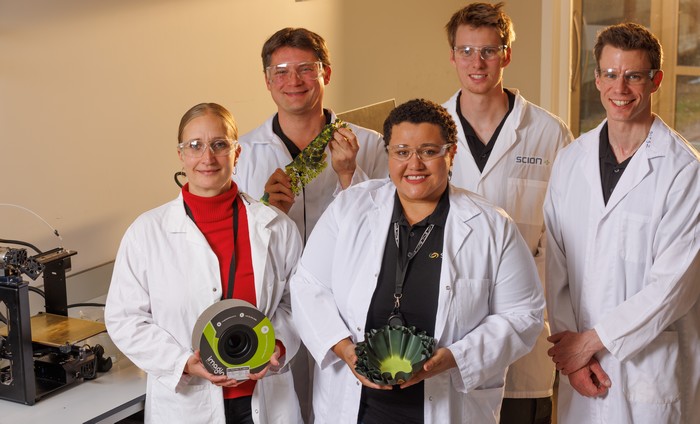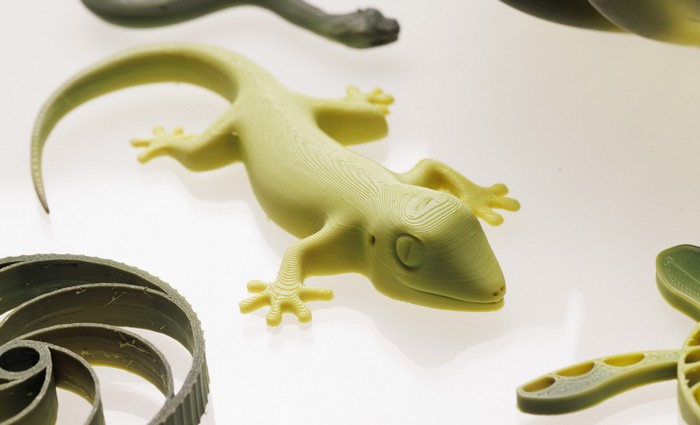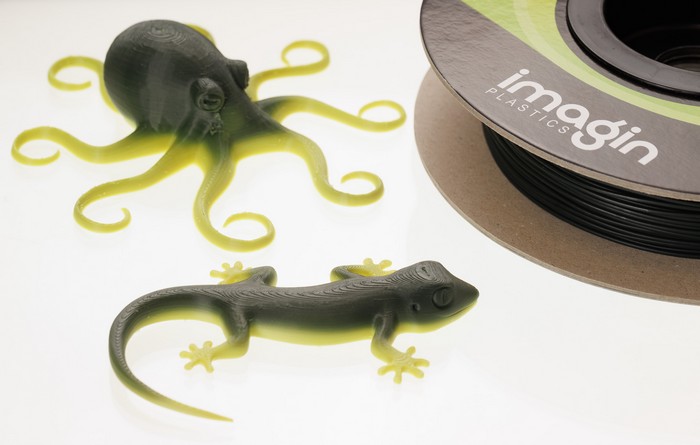Scion innovation leads to flexible 4D printing filament
27 March 2023
For immediate release
A colour-changing and flexible 4D printing filament developed by Scion scientists is set to benefit educators, industry and New Zealand’s fast-growing home-based 3D printing community.
The new filament, known as ‘Morph’ at Scion, has hit the market following a successful research collaboration between Auckland filament manufacturer Imagin Plastics and Crown Research Institute Scion.
3D printing enthusiasts will be able to use the filament to create fun and flexible objects, including bath toys, that change colour with heat. The product, with its special stimuli-responsive feature, is the only flexible filament of its kind in New Zealand.
It’s expected to be popular among 3D printing hobbyists, teachers, and spark commercial interest from the automation industry for its potential to support development of temperature-sensitive machine componentry.
In the education space, Scion’s Morph development team scientist Dr Angelique Greene says the product can be used to teach students about the concept of 3D printing, with an added science component thanks to its flexibility and thermochromism.

“There are other fun 4D printing filaments on the market, but they are typically rigid. We wanted to create a unique, flexible filament that had added functionality.
“Morph is a flexible filament that is also thermochromic; so, when it senses a temperature change, like holding it in your hand for example, it changes colour from black to yellow. This is the first product that combines both properties.”
The concept of 4D printing is similar to 3D, where both print three dimensional objects (using length, width and height), but 4D also features an added dimension which changes over time. In Morph’s case, its thermochromic properties means it changes colour with temperature.
Morph is made from a flexible biodegradable polyester. During its development, Scion scientists successfully printed a number of objects, including phone cases, animals such as a gecko and octopus, as well as moveable objects like stretchy bracelets.


Senior materials scientist Dr Robert Abbel says although it sounds self-evident for a 3D or 4D printing filament to actually print objects, it is not guaranteed.
“Flexible materials are more difficult to print than stiff ones, so we are very happy that it performs so well. This opens up a space for creative product prototyping that has been inaccessible with existing products.”
Greene adds New Zealand is home to a “hobbyist 3D printing army” that will be looking to experiment with the new material as well.
“The true potential of Morph is in the hands of whoever holds it.”
Work to commercialise the Morph 4D printing filament gained impetus when Imagin Plastics picked up the concept after it was showcased at an event for Scion’s industry partners. This followed an in-house design pitch competition, Innovation Jumpstart, which Scion ran at the beginning of 2020 to help foster capability and market validation for developing technologies.
Together, Scion and Imagin Plastics worked on finalising the raw feedstock, before it was then turned into a printable filament.
Ben Blakley, sales and technical manager at Imagin Plastics, says what brought the two teams together was the exciting new applications for 4D printing filament.
“We’ve worked with Scion on projects for a number of years in different capacities and the development potential of this project was two-fold for us – building the relationship further and bringing a 4D printing filament into the market.
“Initially we were interested in having a printing material we could see being used in the education sector, like high schools and universities, that has a fourth dimension to it. It opens up opportunities for students to use it for their own research and development.”
Blakley says as well as education, Morph has potential for use in the likes of the automation industry.
“Machine componentry in the packaging and food processing industries, for example, could use it to detect temperature change, and even program artificial intelligence to recognise it.”
Now Morph is on the market, Greene says Scion is also using it for community education.
“Our role as a Crown Research Institute is to support industry, but it’s also about supporting the communities in which we operate. We can use Morph to do that.”
During the school holidays, Scion is holding a 4D printing interactive workshop on Wednesday 12 April at Te Aka Mauri | Rotorua Library to introduce young people aged 11-plus to the new filament and the world of 3D printing. People can register for the workshop on the library’s website.
Morph is the second printing filament that Scion scientists have developed commercially in partnership with Imagin Plastics, the first being a wood-filled PLA 3D printing filament.
As a partner, Blakely says Scion’s research capabilities create real value.
“There’s no rulebook on how we work together; from our perspective everything’s possible.”
The Morph filament is available through Imagin Plastic’s website
ENDS

